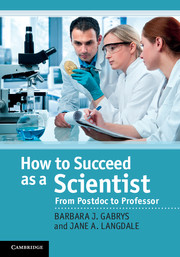Book contents
- Frontmatter
- Contents
- Preface
- Acknowledgements
- Part I Becoming an independent researcher
- Part II Thriving in your new job
- 10 Handling new roles
- 11 Learning from other people
- 12 Managing people
- 13 Building a research group I
- 14 Building a research group II
- 15 Interacting with others
- 16 Designing a taught course
- 17 Giving a good lecture
- 18 Beyond lecturing
- 19 Mentoring
- Part III Managing your career
- Index
- References
10 - Handling new roles
from Part II - Thriving in your new job
Published online by Cambridge University Press: 05 November 2011
- Frontmatter
- Contents
- Preface
- Acknowledgements
- Part I Becoming an independent researcher
- Part II Thriving in your new job
- 10 Handling new roles
- 11 Learning from other people
- 12 Managing people
- 13 Building a research group I
- 14 Building a research group II
- 15 Interacting with others
- 16 Designing a taught course
- 17 Giving a good lecture
- 18 Beyond lecturing
- 19 Mentoring
- Part III Managing your career
- Index
- References
Summary
You have a new job, possibly a new home and certainly new responsibilities. This is an exciting, challenging and often daunting phase of an academic career. How can you ease the transition? This is a good time to take stock of your strengths and weaknesses. What are you naturally good (or bad) at? Are what you perceive as your strengths seen as strengths or weaknesses by those who work with you? Knowing the answers to these questions can help you plan the early stages of this career phase so that you maximise your potential. In this chapter we discuss the general concept of Belbin profiles and what each classification means. More importantly, we discuss which roles within academia will come naturally to each profile and which will need more effort.
The theory
The previous chapters have emphasised the development from dependence on others to independence: how to increasingly take a lead in actions and have more responsibilities. Thus far, interacting with others has been in the background, yet scientists increasingly work in groups and sometimes in large multinational teams. To be effective in the context of a team requires an understanding of what you are naturally good at and an acceptance of the fact that some things are better left to others.
In the last century there was considerable research into effective team-working strategies. In the 1980s and 1990s Meredith Belbin, from the Henley Management School, proposed a model based on ‘team roles’ (Belbin, 1981). In his words:
The term ‘team role’ refers to a tendency to behave, contribute and interrelate with others at work in certain distinctive ways. For practical purposes, one needs to discriminate sharply between a person’s team role and ‘functional role’, where the latter refers to the job demands that a person has been engaged to meet by supplying the requisite technical skills and operational knowledge.
This distinction between team and functional roles is helpful in the case of a conflict between a person’s natural inclinations and job requirements; it can help in renegotiating the role. While originally developed in the context of management teams, this model was subsequently shown to be more generic and valid for non-management teams (Belbin, 2003). A recent review summarises progress since the inception of the original hypothesis (Aritzeta et al., 2007).
- Type
- Chapter
- Information
- How to Succeed as a ScientistFrom Postdoc to Professor, pp. 99 - 107Publisher: Cambridge University PressPrint publication year: 2011



